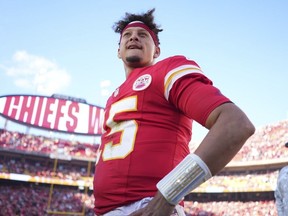Tom Mayenknecht: Meanwhile, the MLB’s LA Dodgers are in a groove, to the detriment of the rest of the league

Bulls-of-the-Week
Few leagues can have a year-over-year decline in television numbers and still call it a good week. Yet that is the real picture behind the National Football League, which continues to rack up huge numbers on television, digital and social — even if was down eight per cent from last year’s record-setting divisional round. Last year checked in at an average of 40 million viewers per divisional playoff game, propped up by a Kansas City-Buffalo matchup that featured Patrick Mahomes, Josh Allen and Taylor Swift and hit 50 million viewers. Last weekend averaged 36.6 million. On one hand, that’s the lowest mark for the divisional round since 2021. On the other, it still puts all the other North American major leagues to shame by comparison, with the World Series (about 20 million last year), NBA Finals (15 million-plus on a good year) and the NHL Stanley Cup Finals, which have hovered around three million to five million viewers on average in recent years.
As expected, the late Sunday window was the high-water mark, with 42.2 million American viewers tuning in to CBS for the Buffalo Bills’ win over the Baltimore Ravens in a matchup that featured leading MVP candidates Lamar Jackson and Allen. The Philadelphia Eagles’ triumph over the Los Angeles Rams in the snow averaged 37.8 million on NBC south of the border, peaking at 47.5 million viewers during dinner hour on the east coast. It was also the network’s best-ever divisional playoff audience. Meanwhile, the Kansas City Chiefs’ win over the Houston Texans drew an American audience of 32.7 million, ESPN’s most-watched NFL game ever.
Shifting seasons: Never in the modern history of Major League Baseball has a team dominated an off-season in the sheer steamrolling fashion that the Los Angeles Dodgers have this year. The scary thing is that they have done what they’ve done in the way of player acquisition as defending World Series champions. In other words, they are a literal example of the best getting even better. They have done so not only with Guggenheim Baseball Investments money but with tremendous financial savvy, using signing bonuses and deferred salaries to make the most of luxury tax provisions. Without even a soft cap, the Dodgers could be baseball’s juggernaut for years to come.
Bears-of-the-Week
That’s great news for baseball fans in Los Angeles. It’s not so inspiring for fans of the other 29 franchises in Major League Baseball. Even traditional big spenders from big markets such as the New York Yankees, New York Mets and Philadelphia Phillies are feeling somewhat boxed out this year. Imagine the vibe in markets such as Kansas City. With a marathon 162-game regular season, the Dodgers have only increased the odds that many teams stand a good chance of being out of contention by the All-Star break in July. That won’t do a thing for ticket sales and television audiences in the dog days of August and into September.
Dynasties are typically good draws at stadiums and on television. Yet in the case of the Dodgers, they simply might be too good for a long time. They are not only building a North American war chest, they are making a case as one of — if not the — strongest global brands, given their international flavour and remarkable super-star depth. Their financial smarts may very well put pressure on baseball’s economic model in a way we’ve never seen before. How will baseball respond?